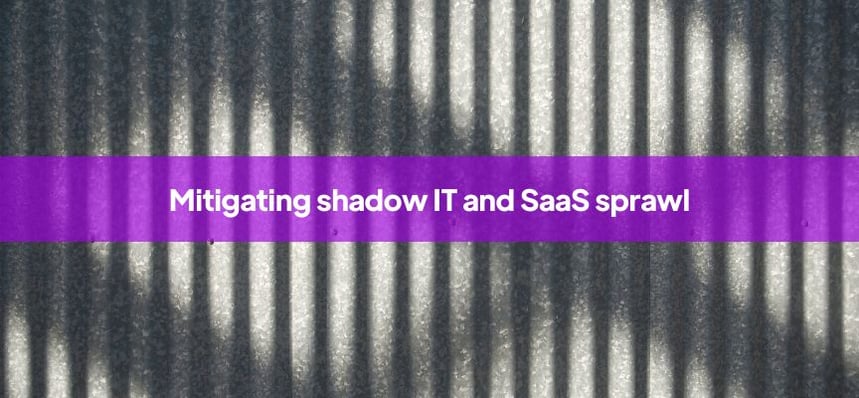As technology continues to permeate every aspect of work, businesses are rapidly adopting various software solutions to streamline operations, enhance productivity, and foster innovation. Between unregulated user adoption of programs and the phenomenon of “shadow IT,” organizations now face an obstacle of ambiguous software accountability and inflated tooling footprints. This confluence of rogue technologies and sprawling subscription lists challenges oversight, budgeting and cybersecurity standards. Let's delve into these issues and understand their implications for modern enterprises, backed by data from recent years.
The shadow IT menace
Shadow IT refers to the use of IT solutions and systems within an organization without the explicit approval or knowledge of the IT department. This clandestine practice has been a growing concern for years, and the statistics paint a vivid picture of the scale of the issue:
- Growth over the years: In 2018, Gartner predicted that by 2020, a third of successful cyberattacks experienced by enterprises would be on their shadow IT resources.
- Impact on security: According to a report by IBM, nearly 83% of organizations have experienced a security incident due to unauthorized IT resources. These incidents not only compromise sensitive data but also often result in substantial financial losses.
- The average cost of a data breach is $4.35 million. The Cost of a Data Breach Report 2022cfound that the average cost of a data breach is around $4.35 million. And that 60% of data breaches drive increased prices, which are passed onto consumers.
The escalation of SaaS sprawl
SaaS sprawl occurs when an organization subscribes to multiple SaaS applications, often with overlapping functionalities, leading to redundancy and increased costs. Recent data highlights the magnitude of this challenge:
- Rising costs: A survey conducted by Blissfully in 2020 revealed that the average mid-sized company uses over 120 different SaaS applications. The cost of this proliferation is substantial, with many businesses underestimating their SaaS spend by up to 90%.
- Redundancy abounds: The same survey found that 80% of the SaaS applications used by organizations have overlapping functionalities. This redundancy results in inefficiencies and complications in data management.
- Security concerns: A 2022 report by Netskope discovered that 95% of organizations experienced at least one instance of sensitive data exposure in their cloud applications, with many of these exposures stemming from SaaS sprawl.
Why businesses must prioritize mitigating shadow IT
The gravity of Shadow IT's impact on businesses is evident, and this is precisely why it's essential for organizations to proactively mitigate this challenge:
- Protecting data and reputation: Mitigating Shadow IT is crucial for safeguarding sensitive business data and preserving an organization's reputation. A data breach can be catastrophic, causing financial losses and eroding customer trust. By addressing Shadow IT, businesses can minimize these risks.
- Ensuring regulatory compliance: Many industries are bound by stringent regulations governing data security and privacy. Failure to comply can lead to severe consequences, including hefty fines. By mitigating Shadow IT, businesses demonstrate a commitment to compliance, reducing potential liabilities.
- Enhancing operational efficiency: When IT resources are centralized and aligned with the organization's overall strategy, businesses can achieve operational efficiencies. They can consolidate resources, reduce redundancy, and improve collaboration, ultimately increasing productivity.
- Budget control: Businesses that address Shadow IT can gain better control over their budgets. They can allocate resources more effectively, avoid unnecessary software expenditures, and ensure that IT investments align with their strategic objectives.
Maximizing value from your complete technology landscape
Modern solutions like Kubeark are playing an increasingly vital role in helping businesses mitigate the risks associated with shadow IT. Kubeark provides businesses with visibility and control over their IT environments, allowing them to monitor and manage the use of unsanctioned software. Leveraging Kubeark's capabilities allows organizations to identify unauthorized software usage, track its impact, and take immediate corrective action, ensuring data security and compliance.
Kubeark's proactive approach to addressing Shadow IT aligns with the need for vigilant mitigation outlined above. Through utilizing advanced technology solutions like Kubeark, businesses can bolster their security, protect their data, and maintain compliance while fostering efficiency and control in an ever-evolving digital landscape.
Final thoughts
In sum, mitigating Shadow IT is not merely a best practice; it's a strategic imperative for businesses in the digital age, and modern tools like Kubeark are becoming indispensable allies in this ongoing battle to safeguard business interests, data, and reputation. By proactively addressing Shadow IT and embracing cutting-edge solutions, businesses can ensure their digital complexity remains an asset rather than a liability. Interested in what Kubeark can do for you? Let’s chat.

